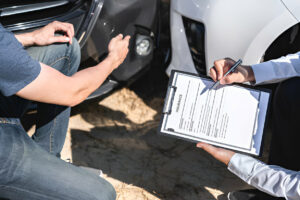A road traffic accident can be a shocking and stressful experience, leaving you with more queries than solutions. Among these questions, many victims find themselves thinking about whether they can receive a courtesy replacement car while dealing with the after-effects of their accident. In this post, we will explore what a courtesy car is, the circumstances under which you may be eligible for one, and the points you should consider.
What is a Courtesy Car?
A courtesy replacement car is a provisional car provided by a garage or a repair shop to people. In contrast, their vehicle is being repaired or declared unroadworthy after a road accident. The primary purpose of a courtesy car is to minimize the inconvenience to your daily life caused by having no access to a vehicle.
Who will Provide Courtesy Cars?
.Insurance Companies: Some people may have coverage under their insurance policy for a courtesy car. This is included in comprehensive insurance, but it is necessary to review your insurance policy. The comprehensive insurance policy consists of a clause to receive a courtesy car.
.Car Repair Garages: Many car repair shops offer courtesy cars as part of their service. When you bring your car in for repairs, ask about the availability of a courtesy car.
.Car Rental Companies: If vehicle repairs are delayed or vehicle parts are not available, a car rental company may be connected. Your insurance can cover the rental vehicle charges under some conditions.
How to get A Courtesy Car?
The process of receiving a courtesy car after a road accident usually involves the following:
Report the Accident to Your Insurance
After making sure that every person in the vehicle is safe after the accident, report the accident to your insurers. If your insurance policy covers a courtesy car point, ensure you receive it. Some insurance companies offer courtesy replacement cars after reporting the accident, while others require a specific request for the temporary vehicle.
Vehicle inspection
The insurance company will arrange an inspection to assess the damage to the vehicle before providing a courtesy replacement car and determining the repair time.
Signing an Agreement with Insurance
Before receiving the replacement car, you must sign an agreement covering the terms and conditions of use for the courtesy replacement car. This agreement will cover the duration to keep the vehicle, vehicle mileage used, and insurance coverage. Always review the terms and conditions carefully to avoid any hidden charges.
Eligibility Criteria for a Courtesy Car
You might be eligible to get a courtesy car, but eligibility can change based on several factors:
1. Insurance Coverage
If you have comprehensive car insurance coverage, review your insurance policy to see if it includes a clause for a courtesy car. Your insurance provider will cover the costs of replacing a vehicle of a similar class while your car is being repaired.
2. Third-Party Liability
In that case, another car driver caused the road accident, and you will be eligible for compensation for the damage to your vehicle and a courtesy car while you wait for vehicle repairs. In such cases, the faulty party’s insurance company may cover the costs and losses.
3. Courtesy Car Through a Garage
If you want your vehicle repaired at a specific garage, you must ask whether they have courtesy cars available.
4. Duration of Vehicle Repairs
The duration of vehicle repairs can also affect whether or not you can receive a courtesy car. If vehicle repairs are expected to take an extended period, many insurance companies provide you with a temporary vehicle to soften your transportation needs.
Steps to Take After a Road Accident
After a road traffic accident, taking specific steps can guarantee that you can receive a courtesy car if needed. Here’s a guide:
1. Inspect the Vehicle Damages
After ensuring everyone in the vehicle is safe and that no serious injuries have occurred, the next step is to inspect the damage to your vehicle. If your car is roadworthy but has minor scratches or dents, you may not get a courtesy car immediately.
2. Speak to Your Insurance Company
Report your insurance company immediately after the accident. Discuss your insurance coverage, including any clauses related to courtesy cars. They can provide information about whether they will provide you with a temporary vehicle and the following conditions.
3. File a Claim
If the accident was non-fault, file a claim with their insurance company. Gather evidence, including photos of vehicle damages, police reports, photos of injuries, CCTV footage and witness statements. The at-fault driver’s insurance may cover the cost of a courtesy car.
4. Choose a Garage
Select a reputable and approved garage for vehicle repairs. Ask them if they offer courtesy cars. If they do not, they may partner with other car rental companies that can provide a vehicle at an agreed cost.
5. Understand the Terms & Conditions
If you’re eligible for a courtesy car, fully understand the terms and conditions. Such as, are there mileage restrictions? Do you need to fuel it up before returning the vehicle? Clarifying these details before receiving the car.
Potential Costs Linked with Courtesy Cars
While the term courtesy car hints that it may come without any cost, some conditions are often attached. Here are some potential costs:
1. Insurance Deductions
If you are using a courtesy car provided through your insurance company, be aware that you may still need to pay your deductions on your insurance policy or the faulty driver’s insurance policy, depending on the accident circumstances.
2. Fuel Costs
Usually, you are responsible for returning the courtesy car with a full fuel tank. Understand the fuel policy before to make sure you’re prepared.
3. Damage Liability
You may be responsible for the costs if the courtesy car sustains damage during your use. Enshat, you treat the vehicle carefully and document its condition upon receiving and returning it.
4. Mileage Charges
Some providers may impose charges based on mileage driven while you have the courtesy car, particularly if it exceeds certain limits. Always ask about any mileage restrictions beforehand.
Alternatives If You Cannot Get a Courtesy Car
If you find that you cannot get a courtesy car through your insurance, repair shop or rental company, consider the following:
1. Share Rides
Using rideshare services like Uber can provide a solution for daily transportation needs. This is helpful for short-term needs while your vehicle is being repaired.
2. Public Transport
Living in an area with reliable public transport can be a cost-effective alternative during the vehicle repair period.
3. Carpooling
Reach out to your friends, family, or colleagues about carpooling. This option allows you to maintain daily activities and go to work while your vehicle is being repaired.
4. Rental Car
If you are involved in a non-fault accident, the faulty party’s insurance will cover rental car costs.
Frequently Asked Questions
What happens if someone borrows your car and they get in an accident?
If the individual driving your car is found to be at fault, they will be liable for the accident. On the other hand, if another driver is found responsible, their insurance should cover the damages and losses. In case of split liability, responsibility might be split between involved parties.
Can I speak to the other insurance company after an accident in the UK?
No. When speaking to them about the accident, you should get the faulty driver’s insurance details; it is not your responsibility.
Whose insurance do I contact if a vehicle hits my vehicle?
If you have comprehensive policy coverage, you should claim it from your own insurance company. However, this may affect your no-claims bonus if the insurer can’t recover the money from the at-fault driver’s insurance company.
What happens if you do not report an accident within 24 hours?
Failure to report an accident can result in points on your driving license, a fine of up to £5,000, or, in the most serious cases, a prison sentence of up to six months.






